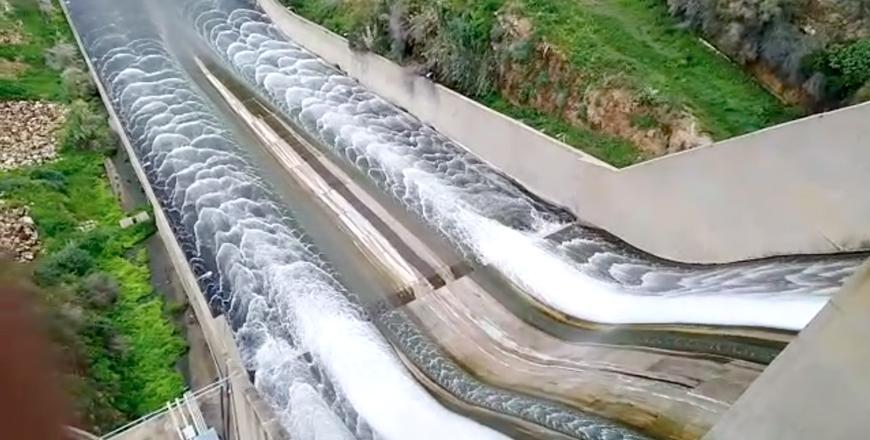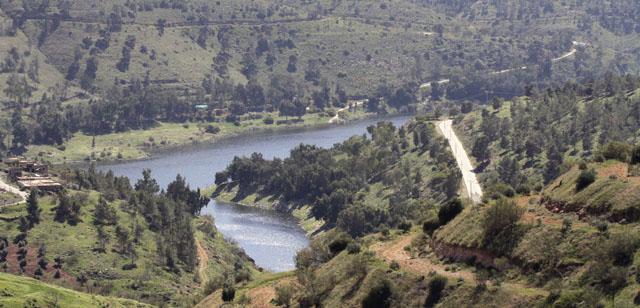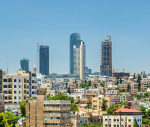You are here
Four of Jordan’s main dams overflow simultaneously in ‘unprecedented’ first
By Hana Namrouqa - Mar 25,2019 - Last updated at Mar 26,2019

Overflow from the King Talal Dam can be seen in this photo taken on Monday. It was the first time four of Jordan’s main dams had overflowed on the same day, according to the Water Ministry (Photo courtesy of the Ministry of Water and Irrigation)
AMMAN — For the first time ever, four of the country’s main dams overflowed simultaneously on Monday, according to officials at the Ministry of Water and Irrigation.
The Mujib Dam, established in Karak Governorate in 2003 with a capacity of 29.8 million cubic metres (mcm), reached its maximum capacity and overflowed for the first time on Monday afternoon, while the recently-expanded 1.7mcm Wadi Shuaib Dam in Balqa Governorate overflowed for the first time this wet season, according to the ministry.
Meanwhile, the 8.1mcm Waleh Dam in Madaba overflowed on Monday afternoon for the fifth time since the start of the wet season in October last year, and the 75mcm-King Talal Dam in Jerash Governorate overflowed for the fourth time this rainy season.
“The overflowing of four of the country’s main dams on the same day during the same rainy season is, indeed, an unprecedented occurrence in the history of the country’s water sector,” an official source at the ministry told The Jordan Times.
The dams now hold more than 55 per cent of their total capacity of 336mcm, the ministry’s official said, noting that during this time last year, the Kingdom’s dams held 40 per cent or 137mcm of their total capacity.
“It has been a generous rainy season, we are thankful... and hopeful that the dams in the south and the 110mcm Wihdeh Dam on the border with Syria receives better floodwater as the rainy season is still ongoing,” the official highlighted.
Jordan Valley Authority Secretary General Ali Kouz said that the authorities “competently” dealt with the overflow, adding that standard procedures were undertaken in cooperation with the concerned authorities to warn farmers and people downstream of the dams.
“Sufficient amounts of rainwater entered the dams on Monday. Waleh Dam received a total of 25 cubic metres of water per second, Mujib Dam received 35 cubic metres per second, King Talal Dam received 15 cubic metres per second and Wadi Shuaib Dam received 10 cubic metres per second... we remain hopeful for the storage of the Wihdeh Dam, Jordan’s largest reservoir, to improve,” Al Kouz said.
A cold air mass began affecting the country on Sunday, pushing temperatures to 5-6ºC below their annual average for this time of year. Most parts of the country received heavy rain, while the southern region, especially areas located 1,300m above sea level, witnessed snowfall on Monday.
The heavy rain prompted the Jordan Water Company (Miyahuna) to suspend water pumping to Amman and Zarqa due to a high level of turbidity from different sources which supply the two metropolitan cities.
In a statement e-mailed to The Jordan Times on Monday, Miyahuna said they expected the water distribution programme in Amman and Zarqa to witness disruptions, indicating that they will resume water pumping once the murkiness of the water drops.
Related Articles
The Kingdom’s 10 major dams now hold 51 per cent of their total capacity of 325 million cubic metres (mcm), a government official said on Sunday.
AMMAN — The Kingdom’s 10 major dams now hold 60 per cent of their total capacity of 325 million cubic metres (mcm), a government official sa
AMMAN — Following a discouraging start of the rainy season and the disappointing storage levels at the country’s 10 dams, the reservoirs are

















